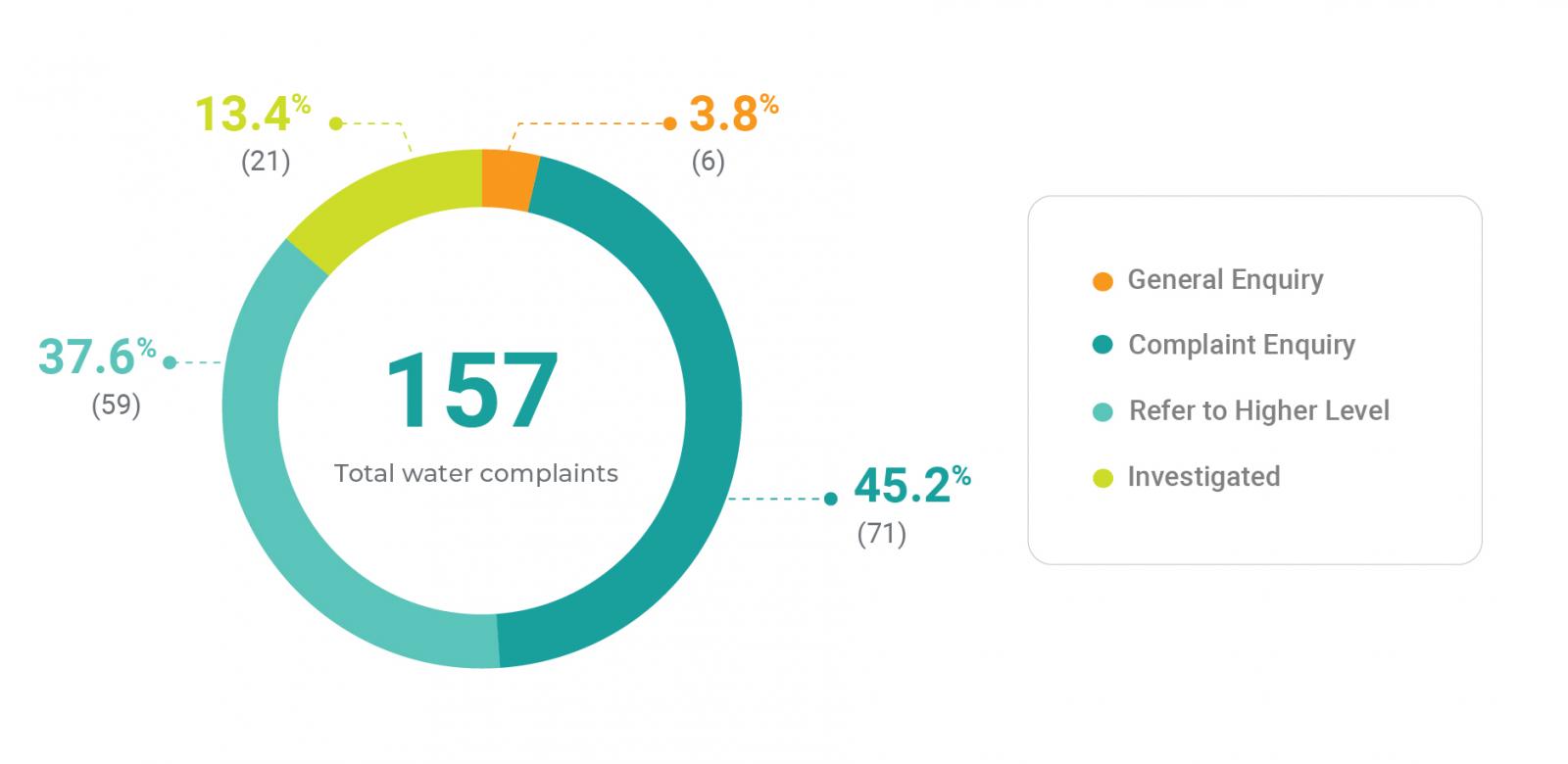-
Home
-
Publications and submissions
-
Reports
-
EWON Insights
-
EWON Insights Jan-Mar 2022
- Water complaints and case studies
Water complaints and case studies
Water complaints make up approximately 5% of the complaints that EWON receive and contain a wide range of issues.

Table 5 —Water issues January to March 2022 including the previous four quarters
| Primary and secondary issue | Jan-Mar 2022 | Oct-Dec 2021 | Jul- Sep 2021 | Apr-Jun 2021 | Jan-Mar 2021 |
|---|---|---|---|---|---|
| Billing > high > disputed | 26 | 37 | 44 | 41 | 34 |
| Customer service > failure to respond | 22 | 16 | 15 | 18 | 26 |
| Customer service > poor service | 19 | 32 | 19 | 25 | 21 |
| General > energy / water | 19 | 18 | 29 | 27 | 26 |
| Land > network assets > maintenance | 15 | 7 | 3 | 7 | 8 |
Table 6 — Water complaint breakdown, January to March 2022
| Complaint type | Number of complaints | Total % |
|---|---|---|
| General enquiry | 6 | 3.8% |
| Complaint enquiry | 71 | 45.2% |
| Refer to higher level | 59 | 37.6% |
| Investigated | 21 | 13.4% |
| Total | 157 | 100% |
General water case studies
Water network operators control and maintain a large network of pipes and sewers throughout NSW to provide drinking water and wastewater services to customers.
The water network is complex, and complaints often concern how water gets to and from a property or confusion about the responsibilities of customers and network operators.
Generally, customers are responsible for maintaining their private pipes into the property, up to the junction where they connect with the mains. This point can be outside the property boundary. Water and sewer mains typically run under roadways in urban areas but can cross private land in more densely populated areas.
When customers purchase a property with an existing dwelling, there are already pipes in place. These properties may have a network asset running across the land, which means the water provider could have an easement on the property for maintenance access. There are restrictions on building over assets, so customers must be aware of these before building a new house or renovating an existing house.
The following complaints look at some of the issues EWON investigates regarding customer or water network operator assets and highlights the complexity of the network operations.
Case Study: Customer required to clear access to sewer shaft
In February 2022 a customer contacted his water provider as sewer water was leaking from beneath a concrete pond above the main sewer at the rear of his property, just outside the property boundary. The provider sent a technician to clear the blockage, but he was unable to clear it due to blocked access from the concrete pond.
The technician told the customer that access to the sewer main shaft would be possible if he removed the concrete pond. The customer paid $200 for someone to remove the concrete pond and asked the provider to send a technician out to the property.
A different technician attended the property and refused to clear the blockage as he could not access the sewer shaft because it was located underground. The technician told the customer that he had to locate the sewer shaft himself. The customer, who was not physically capable of digging due to his age, thought this was unfair and not his responsibility.
He contacted the provider to make a complaint, but did not receive a response. Severe weather then washed sewer leakage into a neighboring property, so he contacted EWON for further assistance.
EWON contacted the provider and it advised that each property connected to its wastewater system via a gravitational sewer system has a sewer inspection shaft. Inspection shafts are owned by the customer, are on their property, and should be accessible at all times for emergencies or maintenance. Water providers require access to the sewer shaft to determine whether the blockage is occurring in the network asset or whether it is part of a private system. Without access, providers cannot determine whether there is an issue within the customer’s privately owned shaft.
EWON told the customer he was required to provide clear access to the sewer shaft and that this would mean that he was responsible for arranging a plumber to locate and raise the shaft. The water provider would then attend the property to inspect and clear the blockage if required. The customer was satisfied with this explanation and arranged for a plumber to attend the property.
Case Study: Property built over a network asset without permission
A customer was in the process of selling a property built over 50 years ago. He received a letter from the legal representative acting on behalf of a water provider advising that there was no record of any approval being given to build a property over or adjacent to a network asset.
He contacted the provider and was advised that it only kept records for 25 years. The provider also advised him that it did not object to the structure remaining, but would not accept responsibility for claims for damage if it needed to do any maintenance work on the wastewater main unless its negligence caused the damage.
The customer contacted EWON after speaking with the provider as he was concerned about the wording of the original letter. He had to provide a copy of the letter to the purchasers during the cooling off period and was worried that it would hinder the completion of sale. As such, the customer wanted the provider to issue an amended letter that would include the information that it had provided to him verbally.
We referred the matter to the provider for resolution at a higher level, with the customer knowing he could return to us if he was unhappy with the outcome.
Case Study: Infrastructure required when building a new property
A customer purchased vacant land to build a house and registered the land in June 2021. In October 2021 his builder applied for a new water connection and received a bill from the provider for $5,600. The customer paid this amount to the provider in instalments.
He then received another bill from the provider for an additional $13,500 and was advised that he would require a second water tank at the property. He was advised by the provider that since the property plans included a granny flat, which was considered a second dwelling, at a minimum a double wastewater pump was required. He then received another bill for $9,700.
The customer contacted EWON as he had a Development Application pending approval with his local council and the issue was causing delays. He had spoken to other people who had built a granny flat in the area and had not required any additional infrastructure. He considered the charges unreasonable.
The provider advised EWON that the initial invoice was for standard fixed charges for all new connections and that additional charges may be incurred if the site has two dwellings.
The provider also told EWON that the customer initially advised that the site was a single dwelling, however a second dwelling (the granny flat) was included on the plans. It noted that second dwellings incur additional costs as outlined in its pricing plan and provided quotes to the customer to review. The provider acknowledged that granny flats previously did not require additional infrastructure, but new requirements meant this was no longer the case
We explained to the customer that the charges in the quotes appeared consistent with the provider’s pricing plan, and that we were unable to negotiate or comment on the quoted amounts or changes in the connection process. The customer was satisfied with EWON’s review and advised that he would contact the provider to discuss the most suitable option for the property.
Case Study: Leak in pipe on common property
A customer reported a leak from the mains at her property to the water provider in February 2022. The provider advised her that the water mains that supplied the property were at the front of the property and as the leak was in the back garden, it was not considered a network asset issue.
On the provider’s recommendation, the customer hired a private plumber to shut off the path valve. However, the plumber confirmed that the leak was coming from the provider’s mains and noted the water meter at the property was not moving, indicating the leak was not part of her private installation.
The customer contacted her provider again but it was still unwilling to send a technician to repair the leak. She then contacted EWON and the complaint was initially referred to the provider at a higher level. However, the provider did not contact the customer and she returned to EWON.
EWON contacted the retailer to obtain information and it advised us that it had met with the customer onsite and confirmed that the leak was not from a network asset. The leak was on private land and from a galvanised pipe, a material that is not used in the network operations. During EWON’s investigation the provider also advised that the tap to turn off the supply to the address was located at the rear of the property and had been replaced.
EWON explained to the customer that the property was part of a joint or common private service, where a single connection point to the main pipe serves multiple properties. This type of infrastructure is more common in older parts of the network where terraced housing is common. Therefore property owners must repair leaks and share associated costs. The customer was happy with the explanation and arranged for the pipe to be replaced.

